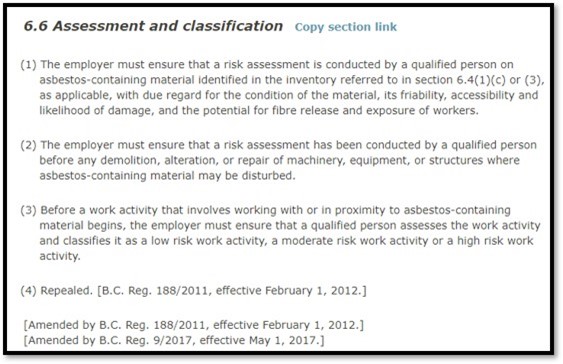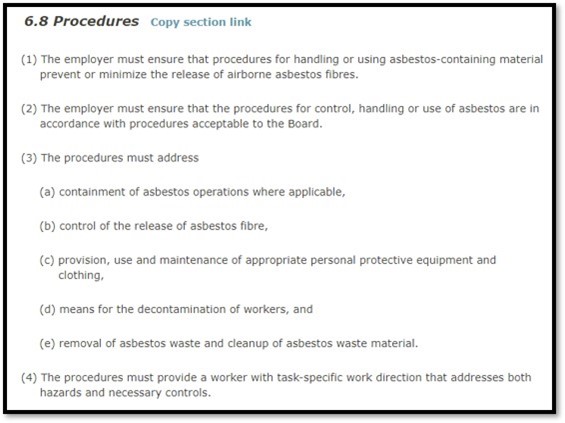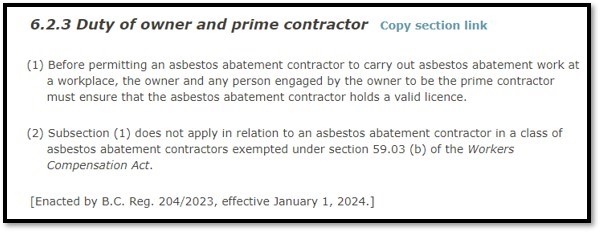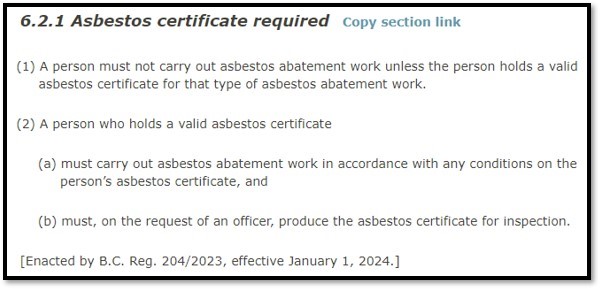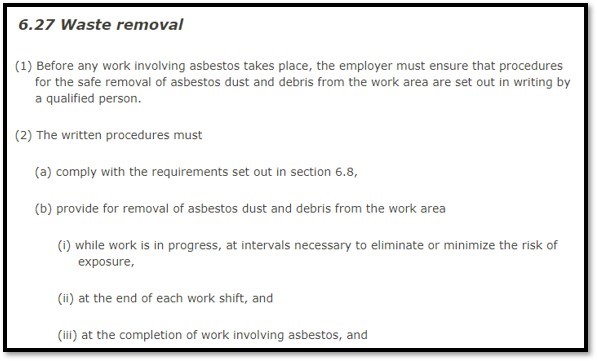Asbestos Abatement Steps – 6 Key Stages
Asbestos Abatement Steps – 6 Key Stages
Asbestos abatement is a critical process to ensure the safety and health of individuals in environments where asbestos-containing materials (ACMs) are present. In British Columbia, the asbestos abatement process is governed by strict regulations to protect workers and the public.
Below are the six essential steps to abate asbestos in BC, complete with the regulatory excerpts as outlined in the regulation.
1. Hazardous materials survey.
Before any abatement work can begin, a comprehensive hazardous materials survey must be conducted. This survey identifies the presence, location, and condition of ACMs in the building. A qualified professional, such as a certified hazardous materials surveyor, performs this survey to ensure all asbestos materials are accurately identified. The survey is crucial as it forms the basis for the subsequent risk assessment and abatement plan.
For building owners, the following regulation outlines this requirement:
2. Risk assessment for removal of the asbestos containing materials, and access risk of the surrounding area.
Following the identification of ACMs, a detailed risk assessment is required. This assessment evaluates the risk associated with the removal of the asbestos-containing materials and the potential impact on the surrounding area. The risk assessment must be thorough and consider all possible hazards to ensure that the abatement process can be carried out safely. It involves evaluating the condition of the ACMs, the extent of contamination, and the potential for asbestos fibers to become airborne during removal.
It is important that your abatement contractor does not write their own risk assessments, because it is a conflict of interest. If provided this opportunity, some contractors may write the removals at a lower risk level to improve their profit, but sometimes the work is not being completed safely at lower risk levels.
3. Safe work procedures written by a licensed abatement contractor or qualified consultant.
These procedures outline the specific methods and safety measures that will be employed during the abatement process to prevent exposure to asbestos fibers. The procedures include details on containment, personal protective equipment (PPE), decontamination, and emergency protocols. They must adhere to all regulatory requirements to ensure the safety of workers and occupants.
4. NOP filed, including:
-
- Licence # of the qualified abatement worker (effective January 01, 2024)
- Licence # of the qualified abatement contractor (effective January 01, 2024)
An NOP must be filed, including the license number of the qualified abatement worker and the qualified abatement contractor. This requirement, effective January 1, 2024, ensures that all abatement work is carried out by licensed professionals. The NOP provides details about the project, including the scope of work, the methods to be used, and the timeline. It must be submitted to the appropriate regulatory authority before the commencement of any abatement activities. In addition, the NOP is posted on your jobsite to advise yourself and the public about the hazardous materials work activity being performed, and which times, and which dates.
The below regulation talks to the obligation of building owners to hire licensed abatement contractors:
5. Abatement by a qualified level 2 abatement worker, under the supervision of a level 3 abatement supervisor.
This step involves the careful removal of ACMs using the methods outlined in the safe work procedures. The abatement process must be meticulously managed to prevent the release of asbestos fibers into the air. Supervisors are responsible for ensuring compliance with all safety protocols and regulatory requirements throughout the abatement process.
6. Waste removal, and disposal of the asbestos containing material. If it weighs less than 5kg, abatement contractors are licensed to transport it, if more than 5kg a roll off bin and have the waste transported by a licensed TDG carrier with asbestos abatement licence.
Proper waste removal and disposal are critical to the abatement process. Asbestos-containing materials must be securely contained and transported to a licensed disposal facility. This ensures that all asbestos waste is handled and disposed of in a manner that prevents environmental contamination and exposure to individuals.
By following these six steps, Winmar Kootenay ensures that asbestos abatement projects are completed safely and in compliance with all relevant regulations. If you need asbestos abatement services in British Columbia, contact us for professional and reliable service.

